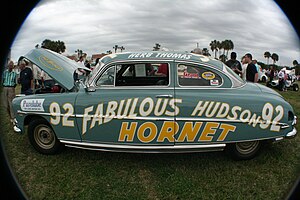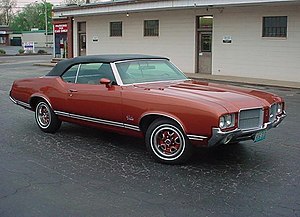The U.S. automotive market is littered with names of former brands, once popular models and entire car companies that have bit the dust. To say that running a car company is a tough job is an understatement ? union relations, federal regulations, fickle customers and profit needs can impact whether a manufacturer lives or dies. A number of American designed and built classic models are no longer sold, one-time top performers or strong niche players that have been retired.

2009 Pontiac G8 GXP, White (Photo credit: Wikipedia)
1. Pontiac G8. Pontiac is dead, but the G8 lives on. Well, sort of. This model was based on the Australian-built Holden Commodore and shipped to the U.S. for the 2008 and 2009 model years. When GM killed off Pontiac in 2009, the G8 died, but later returned as the Chevrolet Caprice, a pursuit vehicle for law enforcement personnel only.
The standard engine was a capable 3.6-liter V-6, but its two V-8 engines are what has helped the G8 to truly shine. Of the two, the larger 6.2-liter engine was a beast, a Corvette-based engine that made 425 horsepower and 415 foot-pounds of torque. This five passenger rear-wheel-drive sedan evoked comparisons with the BMW 5-Series, with its 6-speed Tremec manual transmission and very good handling characteristics. Fewer than 2,000 top-of-the-line G8 GXP models were produced, a model that has been clocked traveling from 0 to 60 mph in just 4.5 seconds. If you own one, you have a contemporary classic in your possession.

1969 AMC Javelin SST. A two-door hardtop ?pony car? made by American Motors Corporation. (Photo credit: Wikipedia)
2. AMC Javelin. Produced from 1967 to 1974, the AMC Javelin was a sport coupe or muscle car that competed with the Ford Mustang, the Chevrolet Camaro, the Dodge Challenger and the Pontiac Firebird among others. This vehicle featured a 2-door hardtop with no B-pillar, sculpted fender pillars and was sold in base and SST editions and, later, as an AMX edition.
Javelin won critical acclaim from automotive writers and enthusiasts alike. It was powered by a base inline-six and offered several V-8 engines including a 335-horsepower motor that displaced at 401 cubic inches or 6.6 liters. AMC offered Javelin for the racing circuit and the coupe was also used by some police departments. Following the 1974 model year, Javelin was replaced by the Matador.

Herb Thomas Fabulous Hudson Hornet. Shot by ?The Daredevil? at Daytona during Speedweeks 2008 (Photo credit: Wikipedia)
3. Hudson Hornet. Hudson was a brand that eventually gave way to the American Motors Corporation and the Hornet was a model produced from 1951 to 1957. This vehicle, available in coupe, convertible and sedan body styles, found its way into NASCAR stock car racing. The Hudson Hornet dominated stock car racing during the early 1950s, winning numerous races.
The first generation Hornet was produced from 1951 to 1954, the second generation model from 1955 to 1957. Earlier models were built by the Hudson Motor Car Company; later models from AMC when it acquired the Hudson brand. The two cars had little in common as the AMC-built model was underpinned by a Nash platform. Hudson used a high compression inline-six to power the Hornet with a V-8 engine added to the line once the car was under AMC?s control. Hornet was discontinued following the 1957 model year when the Hudson name was dropped for Rambler.

1994 Eagle Talon (Photo credit: Wikipedia)
4. Eagle Talon. Yes, there was a car by the name of Eagle Talon. This one was not truly an ?American? vehicle although it was assembled at the Diamond Star Motors plant in Illinois throughout its 9-year model run spanning much of the 1990s. Based on the Mitsubishi Eclipse and also sold as the Plymouth Laser, this front-wheel-drive 2+2 coupe was built for two vehicle generations. The difference between Talon and the other models was the two-tone color scheme with one color atop and another color from below the pillars and across the body.
Talon had the looks of a sport model, with pop up headlamps, integrated turn signals, a swooping body and a stylish liftgate marking this vehicle. Engine choices included a 1.8-liter four initially followed by normally aspirated and turbocharged engines displacing at 2.0 liters. Eagle paired this model with 5-speed manual or 4-speed automatic transmissions. While earliest models achieved an anemic 92 horsepower, later turbocharged models produced a robust 210 horsepower. Production of Talon ended just before Chrysler pulled the plug on the Eagle brand in 1999.

Olds Cutlass. (Photo credit: Wikipedia)
5. Olds Cutlass. GM?s eventual downfall can be traced to discontinuing its 107-year-old Oldsmobile brand in 2004. GM decided to keep Saturn and dump Olds, discontinuing a make that had given us the Eighty-Eight, the Ninety-Eight and the Starfire among other models.
Perhaps Olds? most noteworthy and best-selling model was its Cutlass, a vehicle sold in coupe, convertible, sedan and wagon body styles. Cutlass Supreme, Cruiser and 442 were among the sub-models offered, the latter introduced in 1964 in response to the Pontiac Tempest. The second-generation model, outfitted with 400- or 455-cubic-inch engines was a beast, and was paired with 3- or 4-speed manual or a 3-speed automatic transmission. Especially loved was the Hurst/Olds, a collaboration with Hurst Performance that yielded a Hurst shifter, special paint schemes, a sport suspension and bucket seats.
Behind the five models mentioned here, there are numerous other classic cars that are no longer being made, but are remembered. Plymouth had its Barracuda or ?Cuda, a pony car that competed with the Javelin. The Ford Torino, an intermediate coupe was a good alternative for car shoppers that wanted something larger than a Mustang. Pontiac had its Fiero, a mid-engine sports car that was an assemblage of components from the GM parts bin. Select models from 1984 had engine fire issues, but this 1980s classic showed that at least when it came to styling, GM could build specialty models that rocked.
About Matt KeeganMatt Keegan is a freelance writer. His specialities include automotive, business, college and career, and inspirational articles. Matt founded Auto Trends in April 2008 and expanded it to reflect its current format and editorial policy in Sept. 2010. Matt is a member of the Washington Automotive Press Association and is a contributor to various print and online media sources.
Source: http://www.autotrends.org/2012/12/22/5-unforgettable-classic-american-vehicles/
earl scruggs game of thrones wrestlemania 28 game of thrones season 2 dierks bentley kenny chesney academy of country music awards
কোন মন্তব্য নেই:
একটি মন্তব্য পোস্ট করুন